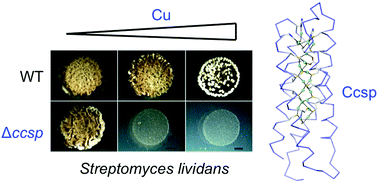当前位置:
X-MOL 学术
›
Metallomics
›
论文详情
Our official English website, www.x-mol.net, welcomes your
feedback! (Note: you will need to create a separate account there.)
A cytosolic copper storage protein provides a second level of copper tolerance in Streptomyces lividans†
Metallomics ( IF 2.9 ) Pub Date : 2017-12-19 00:00:00 , DOI: 10.1039/c7mt00299h Megan L. Straw 1, 2, 3, 4, 5 , Amanda K. Chaplin 1, 2, 3, 4, 5 , Michael A. Hough 1, 2, 3, 4, 5 , Jordi Paps 1, 2, 3, 4, 5 , Vassiliy N. Bavro 1, 2, 3, 4, 5 , Michael T. Wilson 1, 2, 3, 4, 5 , Erik Vijgenboom 6, 7, 8, 9, 10 , Jonathan A. R. Worrall 1, 2, 3, 4, 5
Metallomics ( IF 2.9 ) Pub Date : 2017-12-19 00:00:00 , DOI: 10.1039/c7mt00299h Megan L. Straw 1, 2, 3, 4, 5 , Amanda K. Chaplin 1, 2, 3, 4, 5 , Michael A. Hough 1, 2, 3, 4, 5 , Jordi Paps 1, 2, 3, 4, 5 , Vassiliy N. Bavro 1, 2, 3, 4, 5 , Michael T. Wilson 1, 2, 3, 4, 5 , Erik Vijgenboom 6, 7, 8, 9, 10 , Jonathan A. R. Worrall 1, 2, 3, 4, 5
Affiliation

|
Streptomyces lividans has a distinct dependence on the bioavailability of copper for its morphological development. A cytosolic copper resistance system is operative in S. lividans that serves to preclude deleterious copper levels. This system comprises of several CopZ-like copper chaperones and P1-type ATPases, predominantly under the transcriptional control of a metalloregulator from the copper sensitive operon repressor (CsoR) family. In the present study, we discover a new layer of cytosolic copper resistance in S. lividans that involves a protein belonging to the newly discovered family of copper storage proteins, which we have named Ccsp (cytosolic copper storage protein). From an evolutionary perspective, we find Ccsp homologues to be widespread in Bacteria and extend through into Archaea and Eukaryota. Under copper stress Ccsp is upregulated and consists of a homotetramer assembly capable of binding up to 80 cuprous ions (20 per protomer). X-ray crystallography reveals 18 cysteines, 3 histidines and 1 aspartate are involved in cuprous ion coordination. Loading of cuprous ions to Ccsp is a cooperative process with a Hill coefficient of 1.9 and a CopZ-like copper chaperone can transfer copper to Ccsp. A Δccsp mutant strain indicates that Ccsp is not required under initial copper stress in S. lividans, but as the CsoR/CopZ/ATPase efflux system becomes saturated, Ccsp facilitates a second level of copper tolerance.
中文翻译:

胞质铜存储蛋白在青霉链霉菌中提供了第二个水平的铜耐受性†
Lividans链霉菌(Streptomyces lividans)形态发育对铜的生物利用度有明显的依赖性。在紫葡萄链球菌中可使用胞质铜抗性系统,以防止有害的铜水平。该系统主要由来自铜敏感操纵子阻遏物(CsoR)家族的金属调节剂的转录控制,由几种CopZ样铜伴侣和P 1型ATP酶组成。在本研究中,我们发现了紫葡萄链球菌中新的胞浆铜抗性层它涉及一种属于新发现的铜存储蛋白家族的蛋白,我们将其命名为Ccsp(胞质铜存储蛋白)。从进化的角度来看,我们发现Ccsp同源物在细菌中很普遍,并延伸到古细菌和真核生物中。在铜应力下,Ccsp被上调,由能够结合多达80个亚铜离子(每个protomer为20个)的均四聚体组件组成。X射线晶体学分析显示18个半胱氨酸,3个组氨酸和1个天冬氨酸与亚铜离子配位有关。将铜离子加载到Ccsp是一个合作过程,希尔系数为1.9,类似CopZ的铜分子伴侣可以将铜转移到Ccsp。甲Δ CCSP突变株表明CCSP未在初始铜胁迫下需要变青链霉菌,但随着CsoR / CopZ / ATPase外排系统变得饱和,Ccsp促进了第二级的铜耐受性。
更新日期:2017-12-19
中文翻译:

胞质铜存储蛋白在青霉链霉菌中提供了第二个水平的铜耐受性†
Lividans链霉菌(Streptomyces lividans)形态发育对铜的生物利用度有明显的依赖性。在紫葡萄链球菌中可使用胞质铜抗性系统,以防止有害的铜水平。该系统主要由来自铜敏感操纵子阻遏物(CsoR)家族的金属调节剂的转录控制,由几种CopZ样铜伴侣和P 1型ATP酶组成。在本研究中,我们发现了紫葡萄链球菌中新的胞浆铜抗性层它涉及一种属于新发现的铜存储蛋白家族的蛋白,我们将其命名为Ccsp(胞质铜存储蛋白)。从进化的角度来看,我们发现Ccsp同源物在细菌中很普遍,并延伸到古细菌和真核生物中。在铜应力下,Ccsp被上调,由能够结合多达80个亚铜离子(每个protomer为20个)的均四聚体组件组成。X射线晶体学分析显示18个半胱氨酸,3个组氨酸和1个天冬氨酸与亚铜离子配位有关。将铜离子加载到Ccsp是一个合作过程,希尔系数为1.9,类似CopZ的铜分子伴侣可以将铜转移到Ccsp。甲Δ CCSP突变株表明CCSP未在初始铜胁迫下需要变青链霉菌,但随着CsoR / CopZ / ATPase外排系统变得饱和,Ccsp促进了第二级的铜耐受性。











































 京公网安备 11010802027423号
京公网安备 11010802027423号